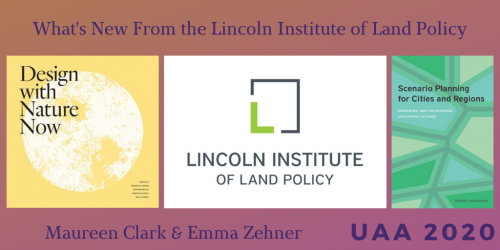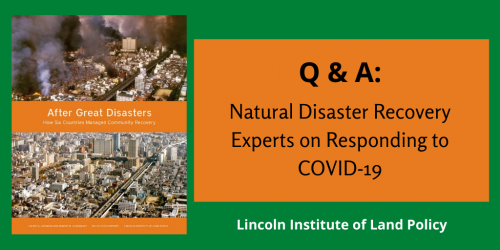Q&A: Robert Goodspeed on Scenario Planning for Cities and Regions

COVID-19 has introduced countless uncertainties into our lives. To prepare for the future, organizations ranging from hospitals to school districts to transit agencies, are using scenario planning, a framework for creating and analyzing multiple plausible versions of the future. In this interview with scenario planning expert Robert Goodspeed, he offers his perspective on how communities can use this planning tool to deal with the evolving pandemic. Goodspeed is an assistant professor of urban and regional planning at the University of Michigan, author of Scenario Planning for Cities and Regions: Managing and Envisioning Uncertainties (Lincoln Institute of Land Policy, April 2020), the first in-depth examination of how planners and communities can use this method. Goodspeed is also a board member of the Lincoln Institute’s Consortium for Scenario Planning.
• • • • • •
Emma Zehner: How can communities use scenario planning during the current COVID-19 pandemic, and who would benefit from using it most?
Robert Goodspeed: Essentially, scenario planning is a tool that helps decision makers anticipate uncertain forces in the future. Local governments, nonprofit groups, and other organizations do not have the luxury of waiting to see what the rate of infection from COVID-19 will be in a year, or how the economic impacts will play out. They need to act now, and yet their decisions will have consequences for years to come.
Regardless of the application, scenario planning addresses the same core question: How can we make decisions that will hold up in the future, whatever it brings.
Already, local community leaders who have not previously participated in scenario planning now see its value, and urban planners and land use professionals are realizing how all long-range plans need to accommodate major uncertainties. This is a good time to look into scenario planning, especially for those cities or towns that are in the middle of considering long-term decisions and planning.
Incidentally, before this pandemic, some experts developed scenarios that might have warned of the events we are experiencing now. They feel these warnings were not adequately heeded. However, many of the preparations which have been made over the years, such as the creation of emergency operations centers and material stockpiles, were no doubt influenced by these scenario exercises.
While my book focuses on the use of scenarios in urban planning, there is also a strong tradition of using scenarios in the fields of public health and emergency management to prepare for things such as global pandemics. Andrew Lakoff describes this application in his book Unprepared: Global Health in a Time of Emergency.
EZ: What do you recommend for those who might try scenario planning for the first time during or after this pandemic? For those who have used it before, how might this context be different?
RG: Scenario planning has a lot of power and complexity. Individual practitioners and organizations build their experience and skill with it over time. Many regions or organizations will start with individual scenario projects to learn the methods and maybe do a strictly qualitative workshop-based project. Regions and organizations that have used it many times may insert it into multiple plans or decisions that they are making. In the current moment, organizations starting from scratch probably should focus on a particular plan or decision, allowing them to dip their toes in the water and explore methods and figure out how to use them effectively. For those who already have more experience, this is probably a good time to broaden or deepen their practice. For example, they could incorporate more possible futures or involve experts from new fields like public health.
EZ: Have you seen a growing interest in learning about this tool since the crisis started?
RG: In recent years, interest in scenario planning has been building for various reasons. Plenty of places are not happy with conventional trends and have sought it out as a method to envision a more sustainable future. And now the current events are reinforcing the broader sense in the field that scenario planning is a tool that should be embraced and used more widely. Massive uncertainties facing cities seem to have broadened interest in scenario planning. I hope the book can give people the guidance and ideas they are looking for, help make planning more impactful, and lead to better decisions and greater overall community resilience.
Often hazard and disaster staff are pretty separate from long-range land use and transportation planners. In order to use scenario planning to address this pandemic, practitioners may have to bridge these and other communities. This may eventually foster greater collaboration. In the meantime, people are focused on very immediate needs, and rightfully so.
Hopefully, the pandemic will illustrate how valuable it is to create plans that contain scenarios for different levels of growth. All plans should address key uncertainties about local economic activity, growth, and decline.
EZ: How has scenario planning been used to prepare for or recover from other types of disasters, and how can scenario planning address another huge public health crisis of our time—climate change? What case studies from your book might be instructive?
RG: Scenario planning has been used very effectively in the Great Lakes region to plan for lake levels and storm severity. Richard Norton at the University of Michigan has created a nice framework that uses scenarios to help communities consider how they can change their land use regulations to prevent coastal erosion and the destruction of infrastructure. Cities are also starting to look more seriously at climate scenarios, varying from sea level rise in coastal communities to urban heat scenarios in more inland cities. I think there is a lot more potential there and one approach in my book described an example—the Central New Mexico Climate Change Scenario Planning Project—which addresses flooding and wildfires and tries to consider how land use sales would interact with those different issues.
The approach in the book focuses on cases from the past, but I can only imagine projects currently underway or in the planning stages will advance our ability to apply these methods to issues related to climate change. There is also growing interest in understanding how climate change may shift migration patterns between more vulnerable and less vulnerable regions. In the end, we need plans that can accommodate different growth trajectories for different places. This is less about climate science and more about making flexible decisions regarding land use and infrastructure that allow cities to adjust if population declines or if a city sees an influx in population.
EZ: What scenario do you believe is most likely to play out right now?
RG: In the area of urban planning, a few trends are already apparent, although I haven’t had the time or resources to analyze them formally. The impact of the pandemic and stay-at-home orders on retail will be significant and will have big effects on land use. Retail vacancies were already a growing trend before this pandemic, so it seems reasonable to expect the coronavirus will accelerate that pattern, creating opportunities for local redevelopment. Online retailers like Amazon and food delivery companies may emerge stronger.
On the transportation side, I expect public transit and ride-sharing to make slow recoveries, but in many cities there is an even greater push toward enhancing pedestrian or bicycle infrastructure.
Finally, the unequal impact of COVID-19 on different racial groups is highlighting longstanding spatial inequity. After the pandemic eases, I hope that urban revitalization will be accompanied by renewed commitments to public health, equity, sustainability, and resilience. Where that happens, planning professionals, and methods like scenario planning, will have an important role to play.






